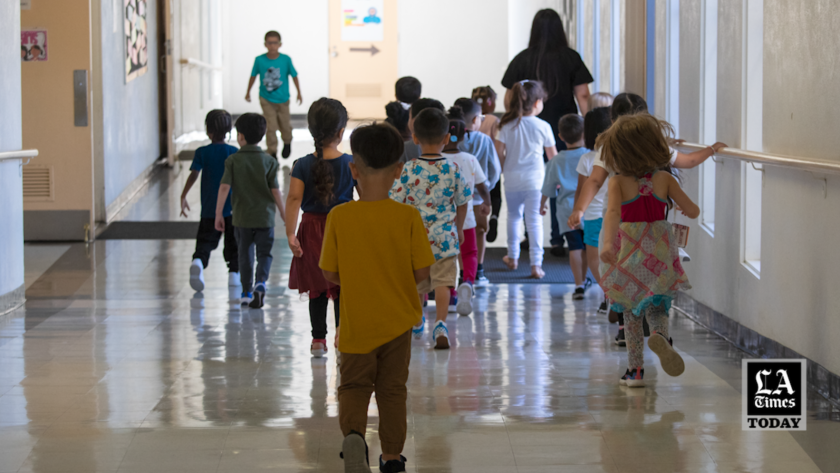Biting, kicking, hurling blocks. Preschools struggle with California law limiting expulsion
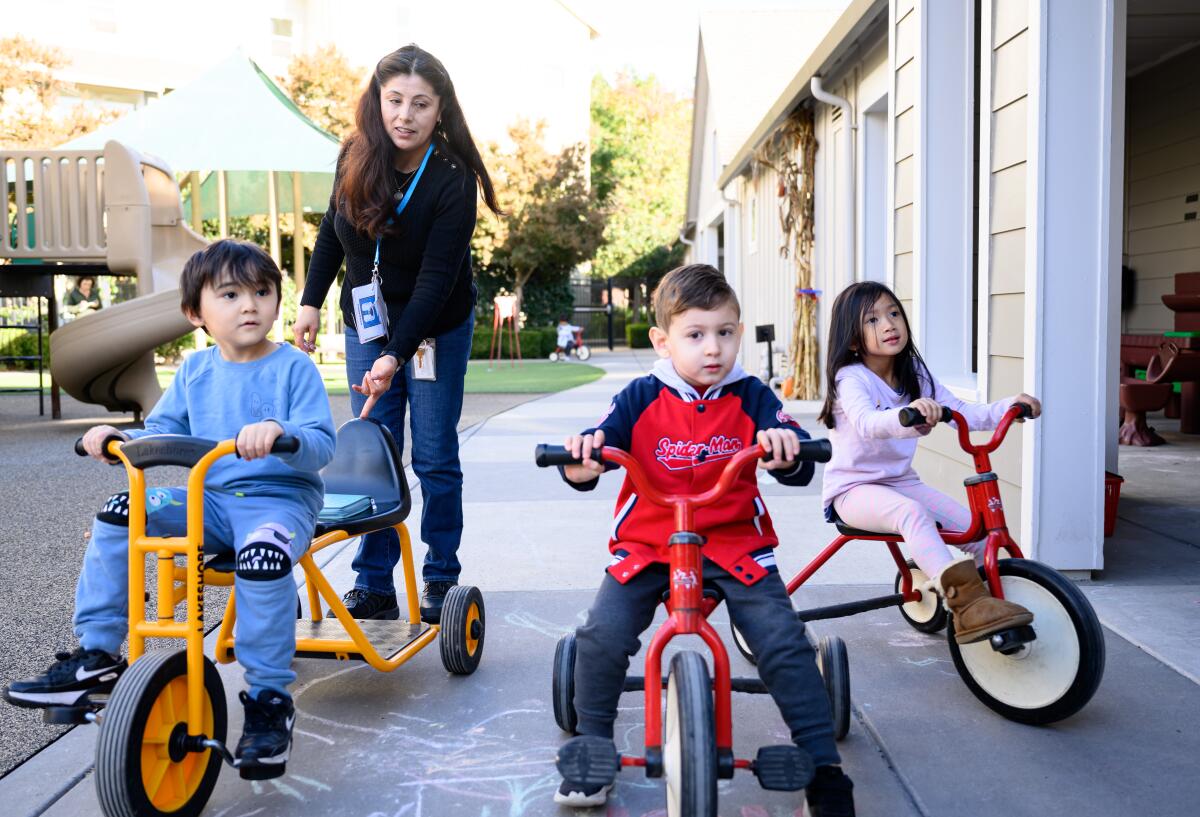
- Share via
Kristin Hills is at her wits’ end with how to handle the behavior problems in her preschool classrooms.
Since the COVID-19 pandemic began, children at the state preschools she oversees in Mendocino County have been acting out. Biting has become more frequent among the 3-year-olds. Hitting and kicking are commonplace. A few children have started hurling wooden blocks and even chairs across the classroom. In at least a third of her 17 classrooms, she said, the behaviors may endanger other children and teachers.
In the past, Hills might have called a parent to come pick up their ill-behaved child early. Now her options are limited, and preschools like hers must manage difficult behaviors on their own.
California began passing a series of highly lauded laws that restrict state-funded child care centers from suspending or expelling children two years before the pandemic. The legislation was part of a national wave that followed a 2014 Obama administration statement condemning preschool expulsion and clarifying that the practice was banned at federally-funded Head Start programs. At least 29 states now have policies restricting or eliminating exclusionary discipline.
“It was a great thing for California, and I believe it will be a great thing for children, especially small Black boys,” said Khieem Jackson, co-founder of Black Men for Educational Equity, which co-sponsored the bill. “It’s a tool that will help us mitigate the preschool-to-prison pipeline.”
But the lingering effects of the pandemic on children’s behavior has made for stressful times in many preschool classrooms, and early childhood educators say the new discipline regulations are proving difficult to implement. Schools must go through a specific series of steps and work with a family before removing a child from school, and families have a right to appeal such decisions, a process that can take more than six months. While most policies in other states apply to all types of child care settings, the California law only applies to programs receiving state funding; private preschools set their own rules.
“I don’t know anyone who disagrees with the need for this. No one wants to suspend and expel children,” said Hills. “But it’s hard.”
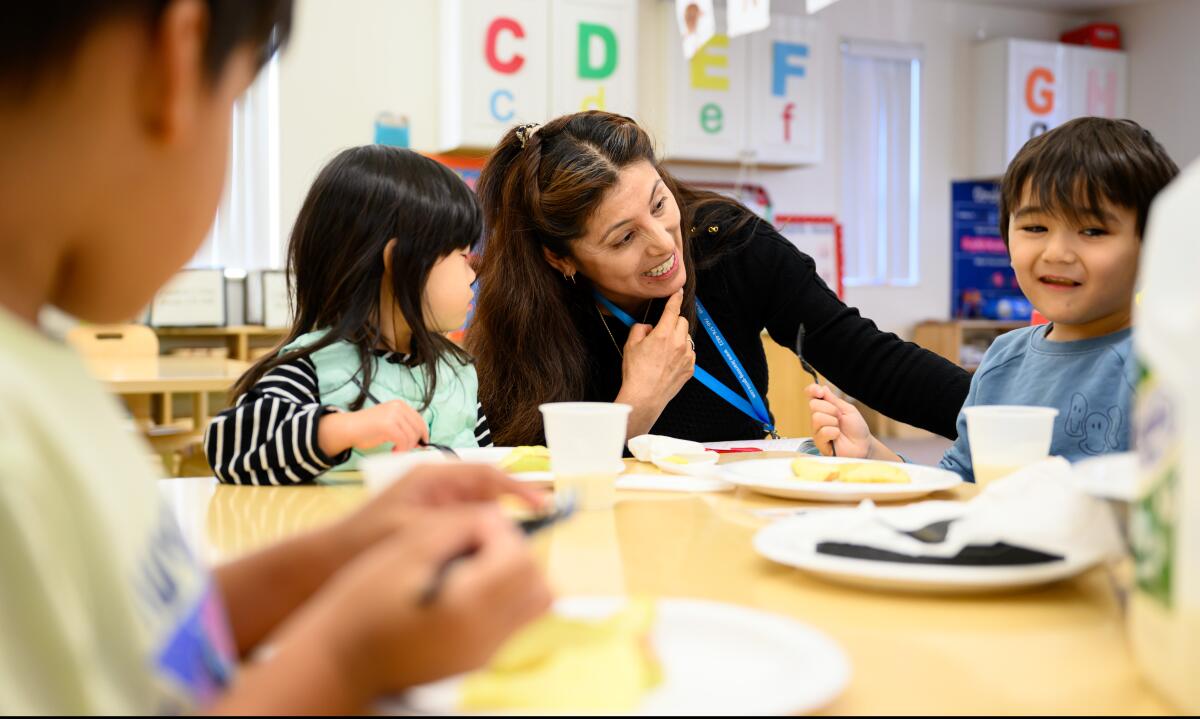
When a student acts out, Hills says there’s little they can do. They can’t call the parents to come pick up their child, something the legislation considers suspension. Even separating the child from the group is difficult, because the law requires that a fully qualified teacher be with them, rather than an aide. In her small centers, there just aren’t enough high-level staff.
There is universal agreement based on decades of research that exclusionary discipline in preschool is harmful to children. One month ago, the American Academy of Pediatrics released a statement detailing the “dire” consequences of expulsion. The practice, it wrote, can cause lifelong harm and disproportionately affects children of color, children with disabilities, and children with adverse childhood experiences, including poverty, abuse, neglect and instability.
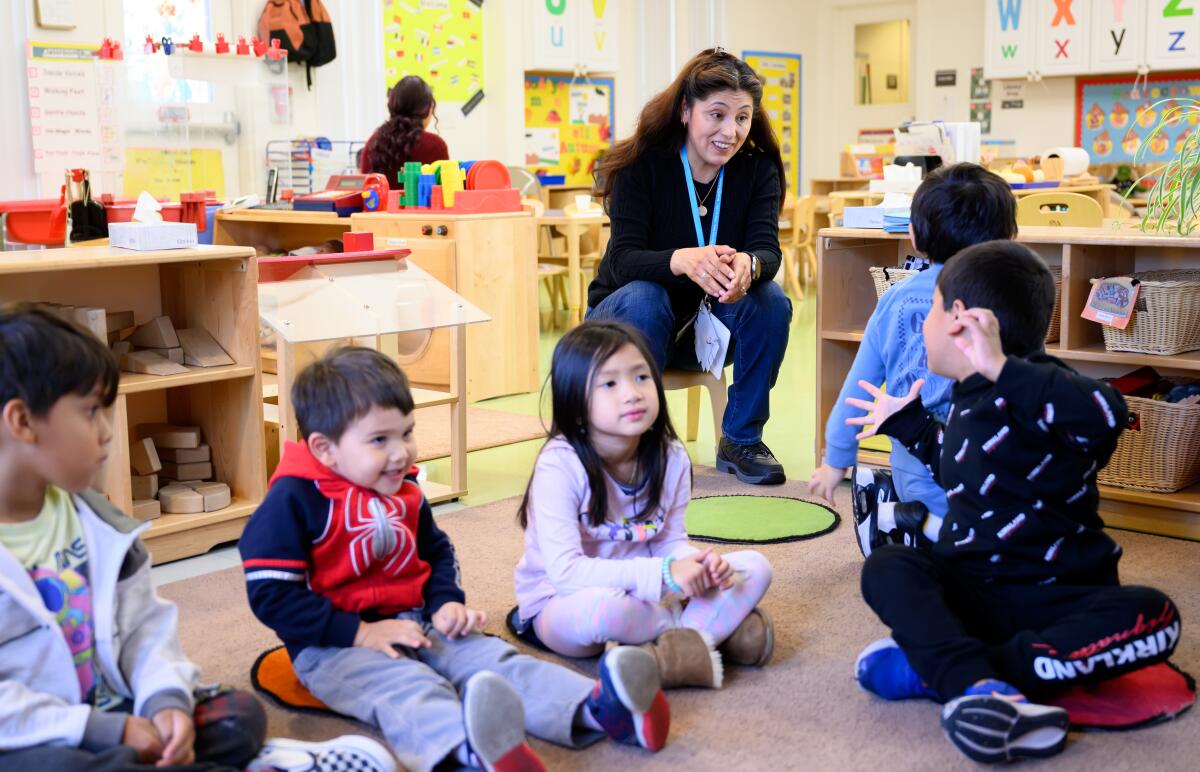
The pediatrics academy statement also offered proven solutions. At such a young age, children’s brains are still malleable, and teachers can learn to work with even the most severe behaviors. Studies suggest that providing classroom visits from mental health consultants, for example, can improve behavior and lower expulsion rates.
The California legislation provides additional funding to programs that hire mental health consultants. But some child care directors say the funding is not enough, and the shortage of mental health providers makes consultants difficult to hire.
Hills said that with intensive behavioral support, behaviors often improve. But the challenge is immediate.
“If I have a site supervisor who’s melted down because she’s got three kids who are melting down, I need to get her through the rest of her day before I can go searching” for a counselor, said Hills. “It’s so easy to say here’s this list of solutions, when you don’t have time and energy to get to them because you’re putting out fires every day,” she said.
How many preschoolers are expelled?
A 2016 national survey of child health by the federal government showed that 17,000 3- and 4-year-olds had been expelled in the previous year, and another 50,000 had been suspended across public and private programs — a rate of about 250 children involuntarily leaving preschool each day, according to an analysis of the data by the Center for American Progress.
Black children were more than twice as likely to be expelled than white children, and children with a diagnosed disability or social-emotional challenge were 14.5 times more likely to be suspended or expelled than their peers; 82% of the children suspended or expelled were boys.
A seminal 2005 study found that at the time, expulsion was three times more common in preschool programs than elementary, middle and high school. Study author Walter Gilliam, who runs the Buffett Early Childhood Institute at the University of Nebraska, says it is simply easier to expel in child care settings.
Beginning in kindergarten, he explained, children are legally entitled to an education, and expulsion can be an arduous process. But there is no legal right to a preschool education; without specific policies banning the practice, early child care settings can expel students with impunity.
“These are things for which nobody is proud. Parents aren’t proud. The teacher isn’t proud,” said Gilliam. “It’s easy for it to be a very quiet problem.”
California does not yet have data to determine whether the new laws have succeeded in reducing exclusionary discipline at state-funded child centers. But the practice remains common at private preschools, where children may be expelled for hitting, kicking, pushing, biting, throwing objects, acting defiantly, throwing frequent tantrums, running away or because they struggle to function independently, experts said.
All of these behaviors can be developmentally appropriate among preschool children to some degree, but educators say when they happen too often, children may be asked to leave. Research suggests that teachers experiencing job stress, depression or who work in classrooms with too many students and inadequate support are more likely to use exclusionary disciplinary tactics.
The spate of recent laws recognized that children of color are more likely to be suspended or expelled, a problem researchers have tied to implicit bias among teachers. In a 2016 study published by the Yale Child Study Center, Gilliam and colleagues used eye-tracking technology to show that teachers were more likely to closely monitor Black children — especially Black boys — for challenging behaviors, even when no problems were occurring.
The consequences of an early expulsion can be far-reaching. Children who have been expelled from child care settings are 10 times as likely to drop out of high school, and face an increased risk of later being incarcerated.
In the nearer-term, their families face hardship from the sudden disappearance of the child care they rely on and contend with a shame that they say can haunt them for years.
Tunette Powell’s two sons, who are Black, were suspended a combined 12 times during a single year at a child care center on an Air Force base in Omaha, Neb. She wrote her doctoral dissertation on the expulsion of Black children in preschool, speaking with dozens of parents in the process.
“The most damning thing for me was what it did to the parents psychologically, and the way it impacts how they parent and how they love,” said Powell. One parent she interviewed described how the family car ride to preschool went from being a daily moment of connection while listening to music to a stern disciplinary lecture on how the child needed to sit still.
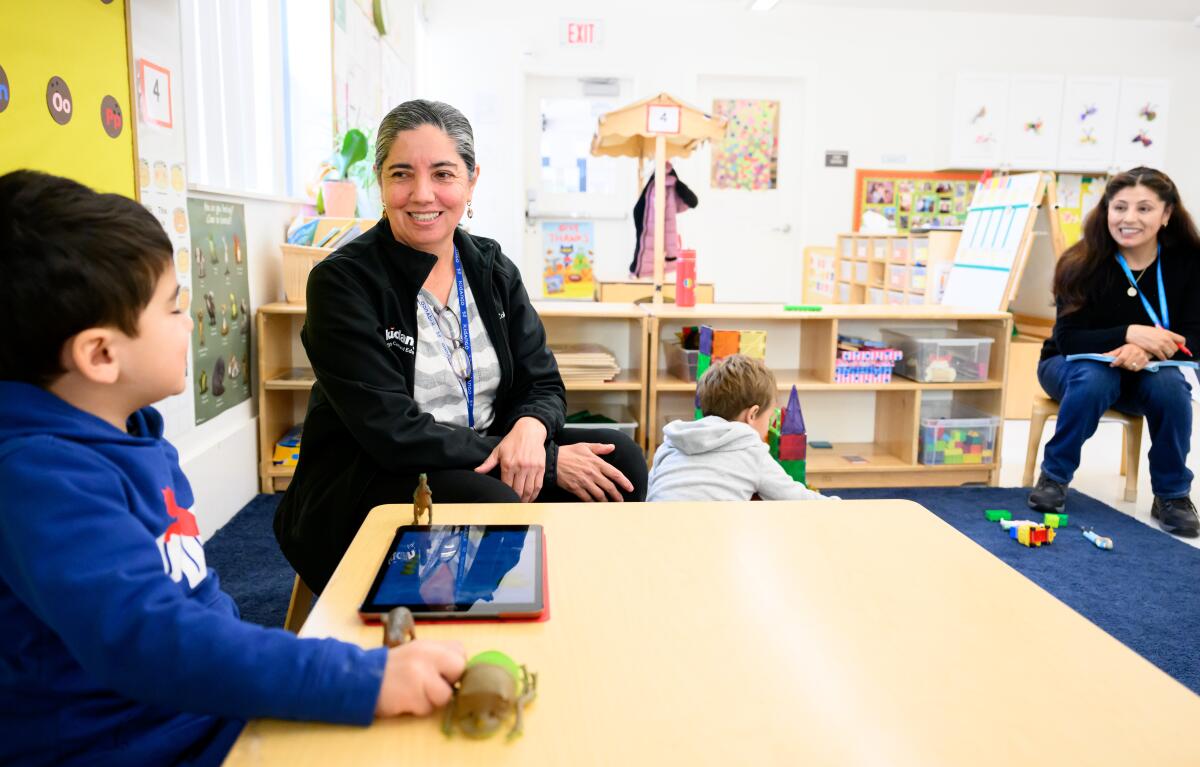
For parents in rural areas in particular, finding a new child care provider can be difficult. Some have to drop out of school or switch jobs to care for their children instead.
Why do kids get expelled?
Children with disabilities experience some of the highest rates of expulsion.
In a recent UC Riverside study of parents of autistic children, one in six reported that their children had been expelled from a child care program. Often the children were expelled for behaviors that were interpreted as being defiant, but were actually linked to an undiagnosed disability.
One mother of a 5-year old boy in Arcadia who was expelled three times suspects he that has an undiagnosed developmental disability. She has been struggling — first with her insurer and now with the school district — to have him assessed for autism and ADHD. She worries the expulsions have affected his sense of self.
He once told her, “I have to go to another school because I can’t stop being bad.”
“When you get expelled from preschool, that’s a tough way to start out your school career. We think kids don’t remember, but they do,” said Rahil Briggs, a psychologist and national director of Zero to Three’s HealthySteps program, which focuses on the health of babies and toddlers.
Briggs said the “terrible twos” and “challenging threes” are known as such for a good reason. “Children’s executive functioning and their frontal lobes are not developed to the point where we can calmly sit down and talk to them about the consequences of their behaviors.”
Yet generally, the providers who care for them are paid the least and offered the fewest supports, said Briggs. Redirecting a young child’s frustration requires a level of creativity and patience that can be challenging in the classroom.
During the pandemic, Briggs said, many families have suffered under the stress of job loss, financial hardship and illness, which can cause behavioral issues in school. Many children also have missed out on valuable social interactions in classrooms and are still struggling to catch up on their social-emotional development.
In a safe and stable environment, she explained, the areas of the brain connected to learning, memory and language are activated. In an environment with a great deal of stress, aggression or fear, those areas get activated instead. “The pandemic was not good for families who were living on the margins already,” Briggs said.
But from the perspective of some California state preschool programs, the behaviors that children are now exhibiting have grown too difficult to manage.
“Folks aren’t equipped with what to do with those children if they can’t expel them,” said Nina Buthee, executive director of EveryChild California, a membership association for child care centers. “It’s having really negative consequences on teacher and student well-being.”
Often, she said, administrators face pressure from teachers and the families of other children in the classroom who do not feel safe and threaten to leave.
Is there a solution to expulsion?
California’s preschool expulsion legislation offers an alternative: funding for mental health consultations.
“I realized that just because you outlaw expulsion doesn’t mean you address the root causes,” said Scott Moore, the chief executive for Kidango, a large child care provider with 57 centers across Northern California, who co-sponsored and helped write the legislation.
With 3,500 students, Kidango employs 21 full-time, state-funded mental health consultants who make weekly visits to each of their classrooms, focusing on helping teachers manage their own stress and respond to their students’ needs.
A companion program for early intervention and inclusion sends developmental specialists into classrooms to help teachers work with children with special needs. A child who frequently ran away from circle time to climb on the furniture, for example, was able to be redirected with the help of pictures to help illustrate the day’s schedule.
On a recent day, mental health consultant Cherry Chan visited one of Kidango’s state preschool classrooms in Newark. She observed the children silently, notebook in hand, as they galloped around the playground to a song playing on a speaker. A few children held back, drawing with chalk on the concrete or looking on dubiously.
Chan made careful notes about the classroom environment: Did the teachers seem happy or stressed? Were they connecting one-on-one with the children?
Afterward, she spent an hour talking alone with two of the teachers. Teacher Cheyenne Crook said the weekly sessions have helped her manage the stress that can make her more irritable in the classroom. Chan has also given her a new lens through which to see a child’s behavioral problems.
“Sometimes you get to the point where you’re like, ‘I feel like I’ve tried everything. What am I going to do now?’” But learning that a tantrum might really be about separation anxiety or trauma at home, she said, has made a difference.
Tena Sloan, who runs Kidango’s mental health program, says the work is challenging, and in many cases, there are no simple solutions to classroom conflicts. But the goal is to “interrupt the patterns” that tend to become entrenched in a classroom.
A child that refuses to sit still at circle time, for example, might be labeled as “defiant,” instead of stressed or overwhelmed, Sloan said. “That determines, do we have empathy for that child? Are we trying to be supportive of that child? Or are we perceiving it as a discipline issue that needs to be punished with stricter and stricter measures?”
This article is part of The Times’ early childhood education initiative, focusing on the learning and development of California children from birth to age 5. For more information about the initiative and its philanthropic funders, go to latimes.com/earlyed.
- Share via
Watch L.A. Times Today at 7 p.m. on Spectrum News 1 on Channel 1 or live stream on the Spectrum News App. Palos Verdes Peninsula and Orange County viewers can watch on Cox Systems on channel 99.
More to Read
Sign up for Essential California
The most important California stories and recommendations in your inbox every morning.
You may occasionally receive promotional content from the Los Angeles Times.
